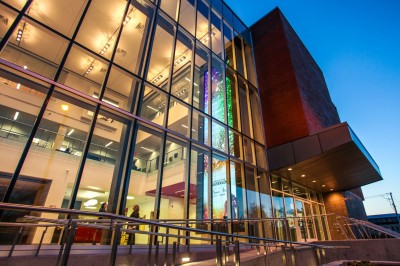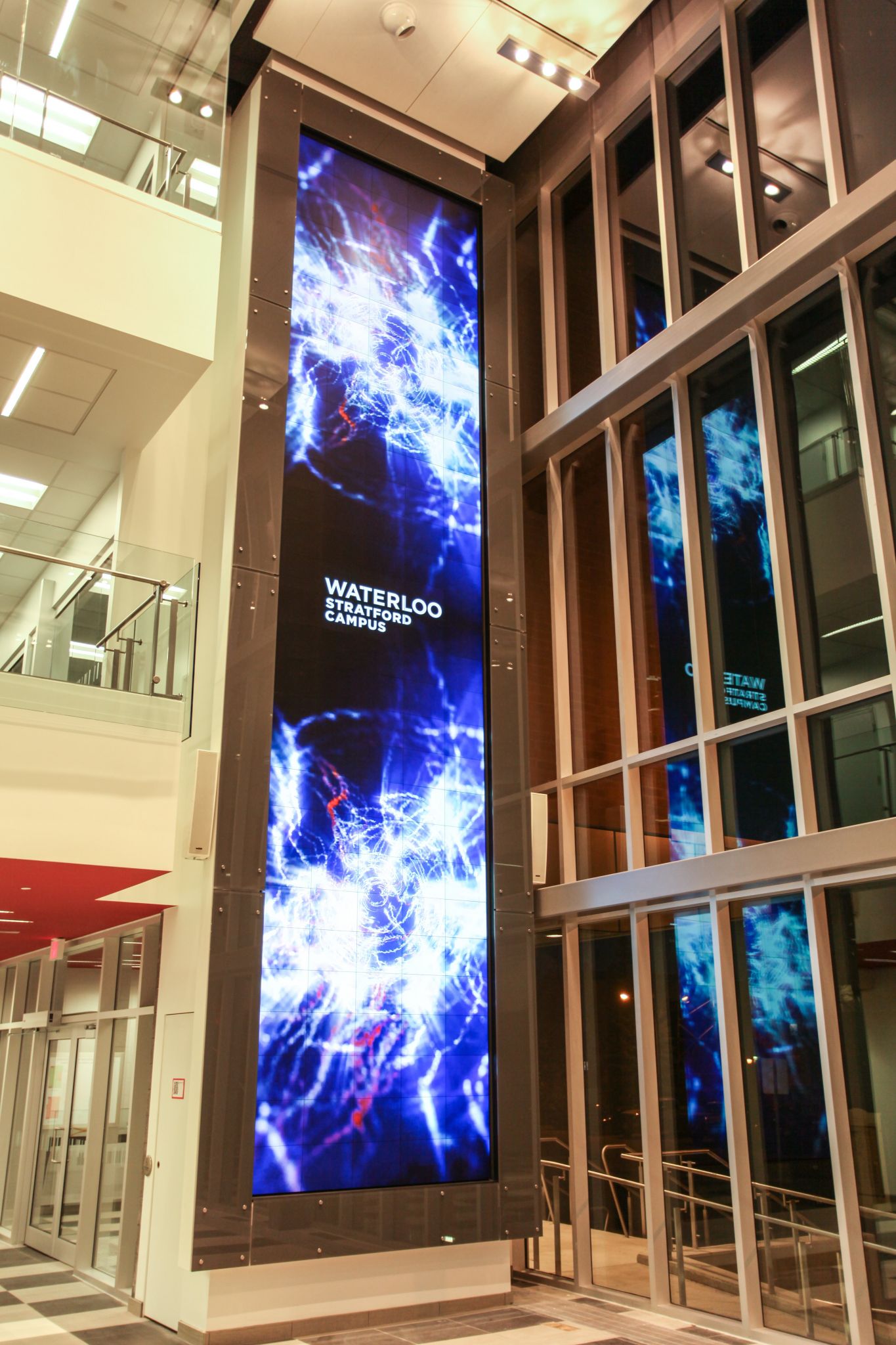By Peter Saunders
On October 16, 2012, the University of Waterloo held the grand opening of its new campus in downtown Stratford, Ont. As home to the university’s digital media program, the campus represents an intersection of technology, arts and business. To visualize this convergence of concepts, the ribbon-cutting ceremony took place in the main campus atrium against the backdrop of a towering 2 x 9-m (6.5 x 30-ft) video wall, comprising 150 MicroTile rear-projection ‘cubes,’ designed and manufactured by Christie Digital Systems Canada in nearby Kitchener, Ont.
In fact, the three-storey structure represented the tallest MicroTiles installation anywhere in the world. Brilliant fireworks were displayed when the wall was illuminated for the first time during the opening celebrations.
To secure the video wall in place, RP Visual Solutions worked with Christie’s research and innovation group to design and produce a rear-mounting bracket with steel support beams. Toronto-based Westbury National Show Systems (WNSS) managed the project and the installation on behalf of the university.
A media management system, video processor and content management software allow students to switch between multiple zones of high-resolution or low-resolution content or portray three-storey tall images with uniform resolution across the entire video wall canvas. Even beginner-level students can use the technology.
“The technology will showcase our students’ work, highlight creativity and provide a unique canvas for complex and detailed digital media research, visualization and commercialization,” explains Ginny Dybenko, the campus’ executive director.
“It was a very magical moment for me to see MicroTiles in a higher-education setting, knowing they will make a difference in advancing students’ and researchers’ knowledge of digital media,” says Dave Muscat, Christie’s senior director of sales, who participated in the opening event alongside students, faculty and dignitaries. “We look forward to working with students to develop new ways of collaborating in content creation and design.”
Beyond the video wall’s looming presence, other digital projection and display technologies are already omnipresent across the campus.
Conceptualized as a faceted display system for control room environments, Christie’s Personal Immersive Environment (PIE) arranges four 1.4-m (55-in.) high-definition (HD) liquid crystal displays (LCDs) in portrait mode to create a roughly 90-degree field of view. This can be used to monitor and program the content featured on the larger video wall, but can also be flipped into landscape mode to suit different users’ needs.
Meanwhile, six ceiling-mounted projectors support widescreen, high-resolution presentations on the walls of individual classrooms. Integrated wirelessly into the main network, they can also display campus-wide notifications as needed.

A three-storey video wall at the University of Waterloo’s new campus in Stratford, Ont., marks the tallest installation of Christie MicroTiles anywhere in the world.
“Digital media in the university classroom gives students access to technologies that are rapidly evolving in today’s economy,” says Paul Salvini, Christie’s chief technology officer (CTO). “The shaping of the global digital economy begins where students can practice, develop and innovate firsthand and researchers can generate ideas.”
Global growth
Video walls—whether in the form of LCDs, front- or rear-projection systems, light-emitting diode (LED) arrays or plasma displays—are becoming an ever-more mainstream form of digital signage. Last August, Futuresource Consulting estimated the global market for video walls would grow by 60 per cent over the course of 2012, with the combination of LCDs and front-projection systems making up more than 90 per cent of this market.
“This is a very fast-growth area and they are popping up everywhere,” says Andy Bowden, HP’s senior marketing manager for digital signage and commercial displays. “We’ll continue to see more and more of them throughout the world.”
Bowden cites a variety of reasons for this trend, where innovations in technology have broken down past barriers, allowing easier adoption of video walls.
For one thing, display bezels (i.e. screen edges) are becoming narrower, sometimes less than 6.4 mm (0.25 in.), enabling nearly seamless tiled configurations. Also, the prices for large LCDs are coming down, although those with ultra-narrow bezels can cost two to three times more than ‘normal-bezel’ screens. And the development of LED backlighting—i.e. to replace fluorescent lighting—is allowing LCDs to become thinner, lighter, sleeker, easier to service and more energy-efficient, with arguably greater uniformity of colour.






